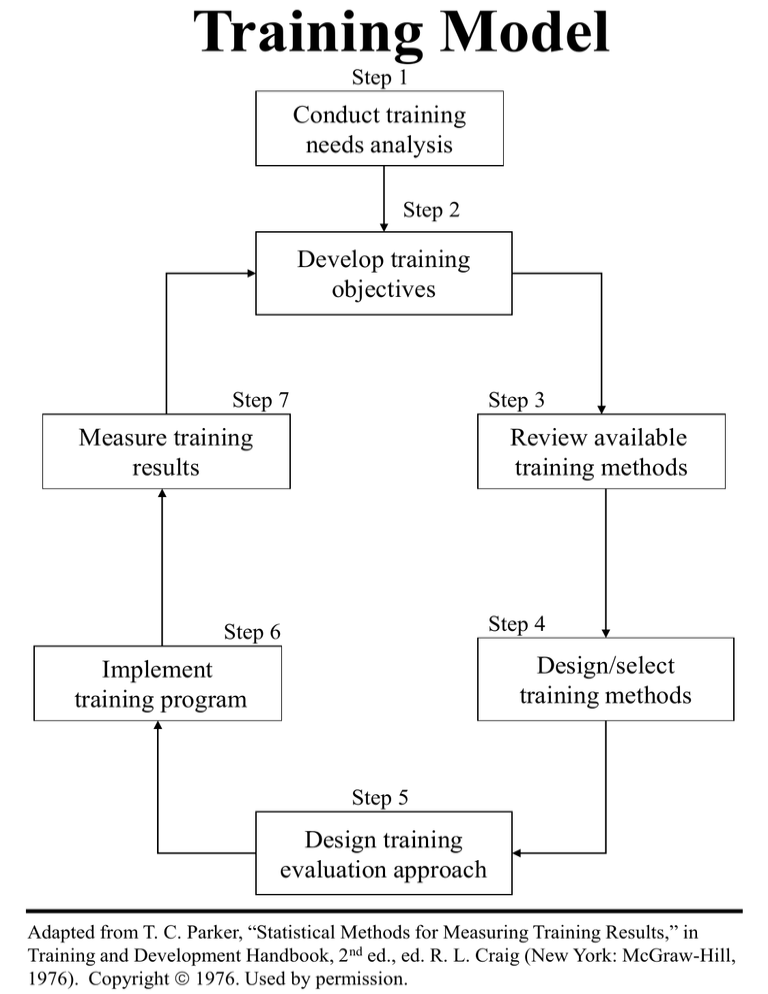
Training Model
Step 1
Conduct training
needs analysis
Step 2
Develop training
objectives
Step 7
Step 3
Measure training
results
Review available
training methods
Step 4
Step 6
Design/select
training methods
Implement
training program
Step 5
Design training
evaluation approach
Adapted from T. C. Parker, “Statistical Methods for Measuring Training Results,” in
Training and Development Handbook, 2nd ed., ed. R. L. Craig (New York: McGraw-Hill,
1976). Copyright 1976. Used by permission.
Needs Analysis
Organizational Analysis
(Where is training needed?)
• Identification of deficits (e.g., skill-based, attitudinal)
• Introduction of new technology, procedures, systems
• Address staffing needs (e.g., strategic planning efforts,
projected personnel needs)
Task Analysis
(What needs to be trained?)
• Use of job analysis information (e.g., specific tasks and/or
KSAs to be trained)
Person Analysis
(Who needs to be trained?)
• Use of performance appraisal information (objective and
subjective data) to help determine employee strengths and
weaknesses
Training
Objectives
It is best if objectives are:
• Specific (regarding what needs to be learned)
• Measurable (regarding how will learning be
assessed)
• Sequenced for optimal learning
• Consistent with the organization’s needs, goals,
and capabilities (e.g., resources)
Basic Learning
Principles
1) Feedback (best if it is specific and immediate)
2) Transfer of Training (e.g., transfer what is learned back
to the job)
3) Reinforcement (use of desired rewards for “proper”
performance)
4) Practice (opportunity to apply what is learned during
training to the job)
“Hands-on” Training
Methods
On-The-Job Training (OJT)
• One of the most frequently used training methods (especially with
regard to skill acquisition)
• Training is specific to the job tasks (e.g., use of actual tools,
equipment, procedures)
• Easy transfer of training back to the job
• Training is dependent on the skill/knowledge and time availability and
motivation level of the trainer
• Often unstructured regarding such things as: what is taught, how
things are taught, the timing and sequencing of what is taught, and the
time spent (focus) on what is taught
• Difficult to determine when, or if, mastery of skills has been achieved
Vestibule Training
(Conducting training sessions on actual job equipment in an area away
from the job site)
• No damage to equipment, or stoppage of processes, if mistakes are
made
• Allows the observation of employees performance in a controlled
environment before they are allowed to work on actual job equipment
• Easy transfer of training back to the job
• Sometimes used as an assessment of ability during a probationary
period
“Hands-on” Training
Methods (cont)
Job Rotation (or Cross-Training)
• Employees can perform more that one set of job tasks (allows
for easier coverage of jobs in case of absences)
• Employees are more able to assist others in specific job duties
• Difficult to match employees skills and abilities to one job, let
alone several ones
• Jobs usually need to be relatively similar in the KSAs that they
require
Apprentice Training
(Learn job skills from a qualified employee across time)
Information Presentation Training
Methods
1) Lectures
•
Relevant to groups of various sizes
•
Difficult to tailor to individual needs
2) Workshops/Seminars/Conferences
•
Transfer of training can be problematic
3) Audio-visual (e.g., videotapes, CDs, DVDs, films, slide
presentations)
•
Ensures consistency of content and presentation
•
Some methods are not easily revised (e.g., costly)
•
After initial cost of production, relatively cheap to use
•
Allows the review of performance
•
Videos are difficult to modify
•
Making videos can be quite expensive
4) Computer-Based Instruction (or Computer Assisted
Instruction) and Web-Based Training
•
Can be individually tailored to match individual needs
or ability level (& individualized assessment possible)
•
Use of realistic graphics
•
Assessment and feedback can be provided quickly
Simulations
1) Behaviorally-based (e.g., flight simulator training, police
officer training)
•
Computer-based, physical equipment
•
Permits practice and the introduction of events,
obstacles, situations
•
Saves training time
•
Allows the review and evaluation of performance
2) Role Playing (individual or group)
•
Types of training include assertiveness, conflict
resolution (e.g., customer complaints), sales
approaches
•
Evaluate performance and provide feedback
•
Actual behavior and performance assessment can be
unstructured
3) Simulation Exercises (e.g., Assessment Center-type)
4) Behavior Role Modeling
•
Observe proper behavior
•
Perform behavior
•
Receive feedback regarding performance of behavior
•
Receive reinforcement for proper behavior
•
Have an opportunity to practice behavior on the job if
feasible (transfer of training)
Recent Training Topics
Cultural Diversity Training
• Increase awareness and appreciation of
differences in customs, norms, preferences, etc.
• Diversity in ideas, skills, interests creates the
potential for more creative and better decisionmaking
• Increasing importance of this due to globalization
Mentoring Programs
Mentor
Protege
Mentor teaches a protégé how to perform specific
tasks; develop within the organization; grow as a
person
How should the mentor and protégé be paired?
• Assigned versus non-assigned
• Cross-gender/race versus same gender/race
Sexual Harassment
Sexual Harassment (Types)
1) Quid Pro Quo (sex as a condition of employment or
basis for employment decisions)
2) Environmental harassment (behavior of a sexual
nature that is unwelcome and that unreasonably
interferes with one’s work performance or creates an
intimidating, hostile, or repressive work environment)
Sexual Harassment Awareness Questions
1) If a consensual relationship already existed
between two employees, than no grounds exist
for sexual harassment
2) An employee must follow a company’s sexual
harassment complaint procedure before filing a
suit of harassment
3) A company is not liable for harassment that
occurs outside of the work environment
4) An organization can be responsible for
harassment of its customers/clients
5) The law protects men against sexual
harassment by females
6) Only a manager or supervisor can sexually
harass an employee
7) A company that takes immediate corrective
action regarding harassment is less likely to be
found liable for the violation
8) A company that has a written policy against
sexual harassment has little to worry about in
terms of legal liability
Sexual Harassment (Some Key Factors)
• Investigating the record as a whole
• Viewing the totality of the circumstances (e.g.,
nature of the relationship, nature of the sexual
advances, context in which the behaviors occurred)
• Examining the evidence on a case by case basis
• Conduct is potentially illegal if the organization
“knew or should have known” of sexual behavior
Sources of harassment:
• Supervisors (company responsibility; agent of the
company)
• Co-workers (corrective action)
• Clients (extent of company control)
Sexual Harassment Training
1) Establish a written policy prohibiting harassment
•
Define sexual harassment
•
Outline complaint procedures
•
Ensure confidentiality of complaints
•
Guarantee protection of those who complain
•
Outline disciplinary action against harassers
•
Tie policy to mission statement of
organization
Training Program Components
a) Introduction and support from top management
•
Establish a shared understanding &
agreement regarding acceptable and
unacceptable behavior
•
Mandatory attendance (management and nonmanagement personnel)
Sexual Harassment Training (cont.)
b) Definition of sexual harassment
•
Use of scenarios, vignettes
•
Role playing
•
Group discussion exercises
c) Communicate nature and extent of the problem
d) Explain individual, institutional, and legal solutions
Sexual Harassment Training (cont.)
3) Establish effective complaint procedures
a) Have multiple designated officials to whom
complaints can be made
b) Train designated officials in “intake” and
investigative interviews
c) Train 1st line supervisors (crucial)
•
Selection interview
•
Orientation
•
Performance appraisals
d) Develop complaint process
•
Stop harassment immediately (if exists)
•
Address victim’s needs
•
Discipline harasser (if necessary)
Vignettes
1.
A group of male sales representatives come to see you. They say
they no longer want to be sent on out-of-town assignments with
female colleagues because they are afraid of sexual harassment
charges.
Do you assure the men they don’t have to travel with women?
Tell the men their fears are groundless?
Arrange for a sexual harassment training session?
Call a department meeting to discuss the matter?
2.
Barb just lost a lot of weight. She starts coming to work in very
short, tight skirts and clinging tops.
Do you ask nothing?
Call Barb in to tell her to dress more appropriately?
Send Barb a memo asking her to dress more appropriately?
3.
XYZ Company is your biggest account. The buyer has been making
unwelcome sexual advances to several women in your office.
Do you ask the women to ignore it?
Tell the buyer not to come back?
Tell the buyer to change his behavior?
Call the buyer’s boss?
Vignettes (cont.)
4.
Ann, a female supervisor, has recently complained to management
about the ongoing sexual advances and innuendo to which she is
exposed on the plant floor. The Plant Manager reminded her that
she was informed about this climate before she accepted her
position. She has been told that she is going to have to be more
assertive and learn to deal with this if she expects to keep her job.
5.
Richard and Janet have worked together for several years. Richard
grabbed Janet’s behind when she was drinking from the water
fountain. When Janet objected, Richard apologized and has never
repeated this behavior again.
Training Evaluation
Criteria
1) Reaction criteria (e.g., via Participant Reaction Forms)
•
Assessment of how participants felt about the
training program (e.g., adequacy of content
coverage, usefulness of material, how material was
delivered)
2) Learning criteria (assessment of what was learning
immediately following training)
3) Behavioral criteria (did learning that occurred during
training transfer back to the job)
4) Results criteria (did the training lead to positive
organizational outcomes e.g., increased profit, better
output, less injuries/accidents)
Measuring Training Effectiveness
1) Did any change occur?
2) Was the change due to training? (Internal
validity)
3) Was the change consistent with the
organization’s goals?
4) Can the change that occurred generalize
to other people and locations? (External
validity)







